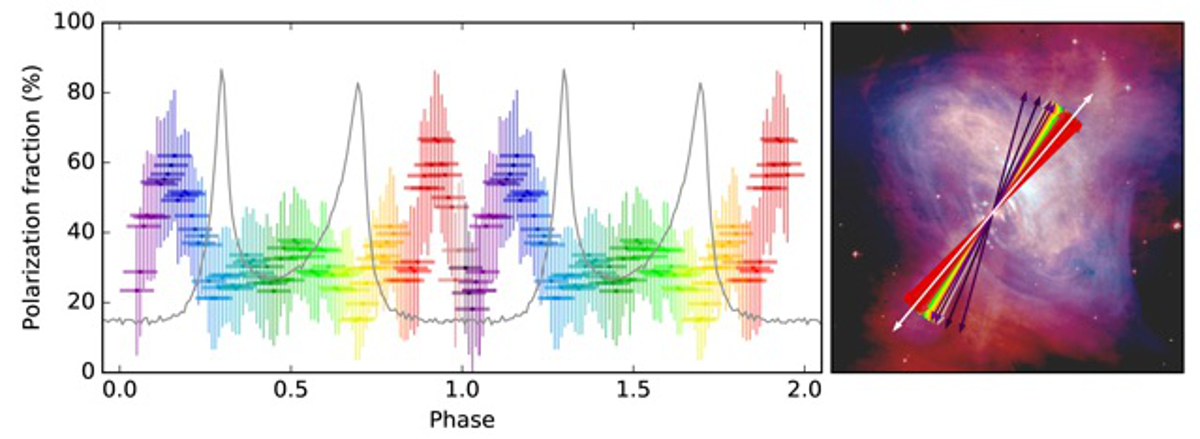
 Credit: ISRO; IUCAA
Credit: ISRO; IUCAA
Pulsar Polarization
A light wave, like any other wave, has a number of wave properties: a wavelength (the distance from peak to peak); an intensity (related to the size of the wave peaks); and a polarization, which describes the plane in which the wave oscillates. While wavelength and intensity provide information on the physical process that generates the wave (its temperature, say, or the power of the source), the polarization of a wave provides information about the geometry of the source (or, often, the environment around the source). Polarization can be linear, in which the wave oscillates up and down in a static plane; or it can be circular, in which the plane of oscillation rotates with time (so that the wave spirals through space). Light we receive from a source may be a mix of polarized and unpolarized waves, so polarization is usually measured as a fraction of polarized to unpolarized light, and (in the case of linear polarization) the angle that the polarized light makes relative to some agreed-upon direction. Because polarization provides information about the geometry of the emitting region, measurement of the polarization of cosmic sources provides unique information about the shape of sources that otherwise can't be spatially resolved. Polarization of X-ray emission from high-energy sources can also be used to study effects of strong gravity near neutron stars and black holes. New, sensitive high-energy X-ray polarization measurements have been made of the Crab pulsar with the CZTI instrument on India's AstroSat observatory. The Crab pulsar is a neutron star which rotates about 30 times per second and which emits a strong, narrow beam of charged particles and radiation. The colored bars in the image above on the left shows the amount of polarized radiation from the Crab pulsar measured by the CZTI as the Crab rotates (the grey line shows the total X-ray intensity, which peaks twice each rotation when the pulsar's beam is pointing towards us). For the first time, the AstroSat observations show that the amount of polarization varies strongly with the spin of the pulsar. The image on the right shows the variation of the angle of the polarized radiation, superposed on an X-ray/optical image of the Crab Nebula. The colored arrows show the changing angle of the plane of the polarized radiation, relative to the angle of the Crab pulsar's jet (shown in white). These polarization measures are helping to significantly revise our existing understanding of the high-energy emission from the Crab pulsar.
Published: November 20, 2017
<
HEA Dictionary ● Archive
● Search HEAPOW
● Other Languages
● HEAPOW on Facebook
● Download all Images
● Education ● HEAD
>

Each week the HEASARC
brings you new, exciting and beautiful images from X-ray and Gamma ray
astronomy. Check back each week and be sure to check out the HEAPOW archive!
Page Author: Dr. Michael F. Corcoran
Last modified Monday, 26-Feb-2024 17:21:03 EST


